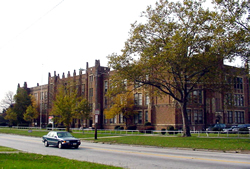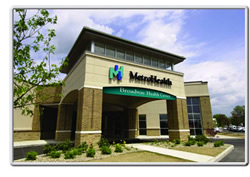
Schools can be designed and operated to serve as multi-purpose community centers, with a variety of activities offered during non-school hours. [Nathan Hale Middle School in Mt. Pleasant] | COMMUNITY SERVICES
GOAL: Connect communities and their institutions in a manner that nurtures the physical, mental and spiritual life of all residents
Issues
The quality of life offered by a neighborhood is measured not only by the quality of its housing but by the quality of its services. Schools, libraries, medical offices, social service agencies and other community facilities provide services that are the prerequisites for a superior quality of life. These services have the power to connect all members of the community to opportunities to achieve economic security and personal fulfillment.
Beyond the services themselves, the buildings that house these facilities can be powerful symbols of community. They embody our shared values and they are a visible acknowledgement that we are only as strong as the weakest among us and that our community’s future depends on our ability to maximize the potential of every member of the community.
The Connecting Cleveland 2020 Citywide Plan recognizes that even the best of services will be poorly delivered if the service facilities are not properly located, sited and designed. Those considerations are, therefore, critical elements of the plan and its implementation. Underlying most issues regarding the provision of community facilities and services is the commitment on the part of the wider community to provide financial and creative resources commensurate with the needs of residents in the City and in each of its neighborhoods. |

Convenient access is a prerequisite to providing effective community services to residents of City neighborhoods. [MetroHealth medical center on Broadway] |
Policies
- Schools as Community Resources. Utilize schools as centers for community education, open in the evenings and weekends for use by students as well as other neighborhood residents, as financial resources permit.
- School Design. Ensure that schools are designed and sited so as to facilitate excellence in education and connections to the surrounding community.
- Education Partnerships. Encourage businesses, institutions, universities and faith-based organizations to partner with local schools in offering diverse education and training opportunities for students and adults.
- Equitable Funding for Schools. Advocate for a statewide system of school funding that responds to the needs of students rather than to the wealth of communities.
- Education Options. Provide Clevelanders with education options that include traditional schools, magnet schools and charter schools, both public and private.
- Coordinated Neighborhood Services. Facilitate cooperation between local service providers and community organizations to work at the neighborhood level to address the comprehensive needs of residents for education, training, health care, and social services.
- Personal Development. Create locally-based programs that foster personal development and ethics as the foundation for strengthening the social fabric of communities and ensuring a better quality of life for residents.
- Community Libraries. Support full-service libraries as centers for lifelong learning and intergenerational learning in each of Cleveland’s neighborhoods.
- Community Health Care. Ensure that medical offices are located so as to supplement full-scale hospitals in serving residents of all Cleveland neighborhoods and that critical health care education is provided to students in elementary and secondary schools.
- Capital Improvements. Coordinate capital improvements planning between the City and the School District to maximize the effectiveness and efficiency of those expenditures.
|





